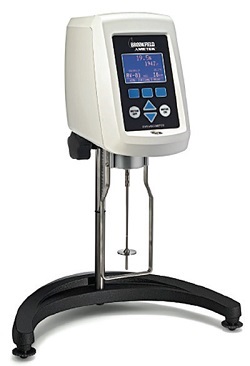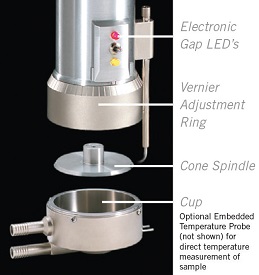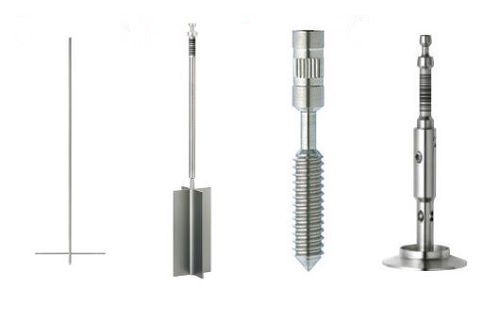Featured Article

Quality control laboratories throughout all industries are the major users of viscometers. If the material being processed is liquid or semi-solid (also referred to as “soft solid”), there is a strong likelihood that viscosity is measured, either in process or at the conclusion of processing, to qualify the end product for acceptability. Measured viscosity values must fall between established limits to certify that the material is in compliance. Most practitioners “grab” samples on the production floor and move them to the QC lab for testing. Some manufacturers make viscosity measurements in process because loss of time in performing the sample evaluation is unacceptable. This article will focus on the QC lab and best practices for ensuring correct viscosity measurements without fail.
Rotational viscometers are the popular choice because of their flexibility for measuring viscosity, no matter how high or low the value. Materials range in consistency from thin fluids, like soups and beverages, to thicker formulations, like skin creams and mascara, to very high-viscosity materials, such as adhesives and dental products. The instrument shown in Figure 1 has a spindle with a disc near the bottom of the shaft. It is immersed in the material under test up to the immersion mark and rotated at a specified speed. Resistance to rotation is sensed by the instrument and the measured torque value is mathematically converted into a viscosity value in scientific units called centipoise (cP) or milliPascal-seconds (mPa.s). Water is the reference material that establishes the benchmark value of 1 cP for its viscosity. All other materials are subsequently measured for viscosity in comparison to water.
 Figure 1 – Rotational viscometer with disc-type spindle.
Figure 1 – Rotational viscometer with disc-type spindle.Measurement of torque obviously implies that the rotational viscometer is a “torque meter.” When choosing a viscometer for the QC lab, it is important to determine what torque range is appropriate for the materials that will be measured. Industry has come to recognize the following general torque ranges with the maximum torque value shown in parentheses:
- LV = low viscosity (673 dyne-cm)
- RV = regular or medium viscosity (7,187 dyne-cm)
- HB = high viscosity (57,496 dyne-cm)
- 5×HB = very high viscosity (287,480 dyne-cm)
Most materials can be measured with viscometers that have either LV or RV torque range. When a test method is established for QC, this specification is very important to ensure that the correct instrument is used. Problems often arise when two different manufacturing facilities try to compare viscosity data from viscometers that have different torque ranges.
Choice of spindle for viscosity measurement is an equally important detail to understand. Disc-type spindles are most commonly used by QC labs because they have been available for 85 years and are automatically supplied with rotational viscometers. Sample size has traditionally been specified as one pint or 500 mL of material in a 600-mL beaker. The bracket around the spindle in Figure 1 serves two purposes: protection of the spindle from accidental knocks by busy lab technicians and outer boundary condition for the shearing action on the material being tested. Some QC labs measure viscosity without the bracket in place to avoid the extra time needed during setup and cleanup. Its absence can cause measured viscosity values to be lower when using the largest size spindles. Use or omission of the bracket should be stated in the test method to ensure that the procedure is complete.
Many QC labs work with smaller sample size, either as a matter of convenience or due to limited availability. It is not uncommon to find 8-ounce Styrofoam cups, for example, because they are low cost and disposable. The protective bracket will not fit into the cup, so cannot be used for viscosity testing. Best practice is to center the spindle in the cup to minimize edge effects from the cup wall during spindle rotation. Failure to do so can result in higher viscosity readings.
Precious materials will allow only the smallest of sample size, often 1 mL or less. Cone spindles are used in this situation. Figure 2 shows the equipment setup. Material is placed in a custom-designed cup that attaches to the viscometer equipped with cone spindle. Two ports on the cup can be connected to a circulating water bath if temperature control of the sample is specified in the test method.
 Figure 2 – Cone spindle with cup for testing small sample size.
Figure 2 – Cone spindle with cup for testing small sample size.Paste-like and semi-solid materials generally have high viscosity and cannot be tested with disc-type spindles because they would dig a hole as the spindle rotates. A variety of special spindles are available to measure viscosity for this situation. Most common has been the T-bar shown at the far left in Figure 3. It is the least expensive and has been the universal choice for many decades. A motorized drive is mounted on the lab stand and firmly holds the viscometer head in place; the drive moves downward and allows the T-bar to corkscrew into the sample material. Viscosity is measured continuously as the T-bar cuts through fresh material with each rotation.
Other choices are also shown in Figure 3. Each has unique advantages and limitations. The vane spindle immerses into the material without destroying sample structure but can only rotate at relatively low speeds. The spiral spindle mimics an augur and provides viscosity data that simulates actual processing conditions for viscous materials. The plate spindle is used with a cone/plate type viscometer and accommodates the smallest sample sizes. Deciding which to use, if not T-bar, is a matter of judgment and usually requires direction from R&D when the test method is created.
 Figure 3 – Spindles for measuring high-viscosity materials (from left to right): T-bar spindle, vane spindle, spiral spindle, and plate spindle.
Figure 3 – Spindles for measuring high-viscosity materials (from left to right): T-bar spindle, vane spindle, spiral spindle, and plate spindle.Having chosen instrument torque range and spindle type, the QC lab must address three remaining issues to complete the specification for the viscosity test method:
- Preparation of sample prior to test
- Temperature control of sample during test
- Length of time for spindle rotation before viscosity value is recorded.
Handling of the sample prior to the test is important if the material is sensitive to movement and disturbance. The bottom line is to make sure the sample is prepared the same way each time, especially in terms of its placement in the sample container, observance of specification for ambient conditions, and amount of time to wait before start of the test procedure.
Temperature control of sample during the QC test is a fundamental consideration. If the material is highly temperature sensitive, then there is little doubt that temperature control will be required. Use of a temperature bath is most common practice in QC labs. R&D will generally specify the control temperature and length of time for conditioning to achieve equilibration.
Length of time for spindle rotation is important to quantify because some materials are time-sensitive. If viscosity decreases while the spindle rotates, this behavior is known as “thixotropy.” Therefore, the viscosity data point is best recorded at a defined time interval after start of the test.
Summarizing the above information into a clearly stated test protocol for viscosity measurement is the key to a best practice that produces consistent and repeatable results. Two final considerations that have significant importance are training of staff and calibration of the instrument. Training must include proper techniques for use and care of the viscometer. A checklist should include the following:
- Verify that the instrument is level
- Connect and detach the spindle by gently raising the coupling to minimize potential damage to the bearing system inside the instrument
- Perform viscosity calibration checks on a scheduled basis or whenever there is a suspect viscosity value recorded during a QC test.
Calibration checks are performed using viscosity standard fluids provided by the instrument manufacturer (see Figure 4). There is a choice of fluid types: silicone or mineral oil. Some industries, such as paints and coatings, will not allow use of silicone in their QC labs. Cone plate viscometers must use mineral oil for calibration checks because the shearing action during spindle rotation can adversely affect silicone material at high shear rates. Viscosity standards have a specific viscosity value stated on each jar of fluid at a specified temperature, such as 25 ℃. The calibration check must be performed in accordance with the manufacturer’s procedure, which includes definition of allowable error for viscosity measurement relative to the value of the standard. When calibration checks fail, contact the manufacturer to review that the procedure has been followed correctly. If the instrument is out of calibration, it must be returned to the manufacturer for service.
 Figure 4 – Viscosity standard fluids for calibration checks on instrument.
Figure 4 – Viscosity standard fluids for calibration checks on instrument. The final best practice is attentive care and maintenance of the viscometer by following the manufacturer’s recommendations. If an annual calibration service is offered, take advantage of the program. Not only does it help ensure long life for the instrument, it provides an updated certificate of calibration. This is very useful to have on file when outside audits are conducted on the QC lab. Proof that instrumentation is up to date is a key requirement.
Companies that follow these best practices are most likely the leaders in their industries. They make a consistent effort to qualify their products for viscosity, which is a key factor in customer acceptance. Satisfied customers become repeat customers, which is the sure path to becoming the best in your business.
Robert G. McGregor is director, High End Lab Instrument Sales, AMETEK Brookfield, Instrumentation & Specialty Controls Division, 11 Commerce Blvd., Middleboro, MA 02346, U.S.A.; tel.: 508-946-6200; e-mail: [email protected]; www.brookfieldengineering.com